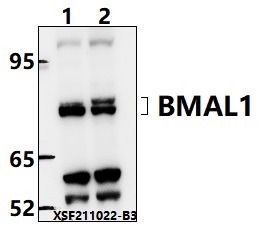BMAL1 (ARNTL) Rabbit Polyclonal Antibody
Frequently bought together (1)
beta Actin Mouse Monoclonal Antibody, Clone OTI1, Loading Control
USD 200.00
Other products for "ARNTL"
Specifications
| Product Data | |
| Applications | IF, IHC, WB |
| Recommended Dilution | WB: 1:1000~1:2000 IHC: 1:50~1:200 IF: 1:50~1:200 |
| Reactivities | Human |
| Host | Rabbit |
| Isotype | IgG |
| Clonality | Polyclonal |
| Immunogen | Synthetic peptide, corresponding to Human BMAL1. |
| Specificity | BMAL1 polyclonal antibody detects endogenous levels of BMAL1 protein. |
| Formulation | Rabbit IgG, 1mg/ml in PBS with 0.02% sodium azide, 50% glycerol, pH7.2 |
| Concentration | 1mg/ml |
| Conjugation | Unconjugated |
| Storage | Store at 4°C short term. Aliquot and store at -20°C long term. Avoid freeze-thaw cycles. |
| Stability | 1 year |
| Predicted Protein Size | ~ 80 kDa |
| Gene Name | aryl hydrocarbon receptor nuclear translocator like |
| Database Link | |
| Background | Circadian rhythms govern many key physiological processes that fluctuate with a period of approximately 24 hours. These processes include the sleep-wake cycle, glucose, lipid and drug metabolism, heart rate, hormone secretion, renal blood flow, and body temperature, as well as basic cellular processes such as DNA repair and the timing of the cell division cycle. The mammalian circadian system consists of many individual tissue-specific clocks (peripheral clocks) that are controlled by a master circadian pacemaker residing in the suprachiasmatic nuclei (SCN) of the brain. The periodic circadian rhythm is prominently manifested by the light-dark cycle, which is sensed by the visual system and processed by the SCN. The SCN processes the light-dark information and synchronizes peripheral clocks through neural and humoral output signals. The cellular circadian clockwork consists of interwoven positive and negative regulatory loops, or limbs. The positive limb includes the CLOCK and BMAL1 proteins, two basic helix-loop-helix-PAS containing transcription factors that bind E box enhancer elements and activate transcription of their target genes. CLOCK is a histone acetyltransferase (HAT) protein, which acetylates both histone H3 and H4. BMAL1 binds to CLOCK and enhances its HAT activity. The CLOCK/BMAL1 dimer exhibits a periodic oscillation in both nuclear/cytoplasmic localization and protein levels, both of which are regulated by phosphorylation. CLOCK/BMAL1 target genes include the Cry and Per genes, whose proteins form the negative limb of the circadian clockwork system. CRY and PER proteins (CRY1, CRY2, PER1, PER2 and PER3) form oligomers that also periodically shuttle between the nucleus and cytoplasm. When in the nucleus, CRY/PER proteins inhibit CLOCK/BMAL1-mediated transcriptional activation, thus completing the circadian transcriptional loop. In tissues, roughly six to eight percent of all genes exhibit a circadian expression pattern. This 24-hour periodicity in gene expression results from coordination of the positive and negative regulatory limbs of the cellular clockwork system, and is fine-tuned by outside signals received from the SCN. |
| Synonyms | ARNTL; Aryl hydrocarbon receptor nuclear translocator-like protein 1; Basic-helix-loop-helix-PAS protein MOP3; bHLH-PAS protein JAP3; BHLHE5; bHLHe5; BMAL1; Brain and muscle ARNT-like 1; Class E basic helix-loop-helix protein 5; Member of PAS protein 3; MOP3; PASD3; PAS domain-containing protein 3 |
| Note | For research use only, not for use in diagnostic procedure. |
| Reference Data | |
Documents
| Product Manuals |
| FAQs |
| SDS |
{0} Product Review(s)
0 Product Review(s)
Submit review
Be the first one to submit a review
Product Citations
*Delivery time may vary from web posted schedule. Occasional delays may occur due to unforeseen
complexities in the preparation of your product. International customers may expect an additional 1-2 weeks
in shipping.






























































































































































































































































 Germany
Germany
 Japan
Japan
 United Kingdom
United Kingdom
 China
China





